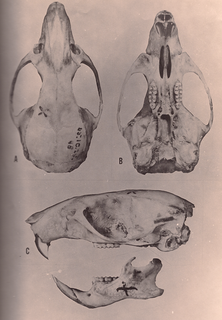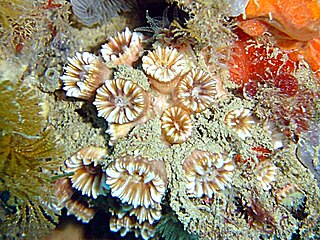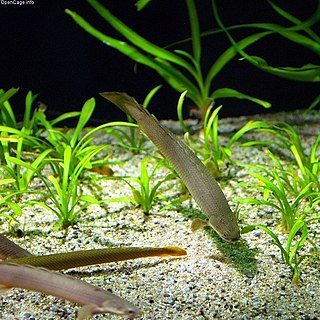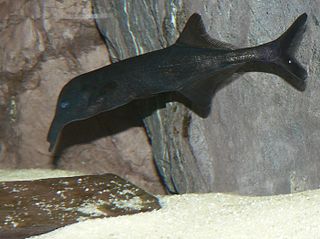
Philip Henry Gosse FRS, known to his friends as Henry, was an English naturalist and populariser of natural science, virtually the inventor of the seawater aquarium, and a painstaking innovator in the study of marine biology. Gosse created and stocked the first public aquarium at the London Zoo in 1853, and coined the term "aquarium" when he published the first manual, The Aquarium: An Unveiling of the Wonders of the Deep Sea, in 1854. His work was the catalyst for an aquarium craze in early Victorian England.

The ruddy quail-dove is a species of bird in the dove and pigeon family Columbidae. It breeds throughout the West Indies, Central America, and tropical South America. It has appeared as a vagrant in Florida and southern Texas. It lays two buff-colored eggs on a flimsy platform built on a shrub. Some nests are built on the ground.

Lamiinae, commonly called flat-faced longhorns, are a subfamily of the longhorn beetle family (Cerambycidae). The subfamily includes over 750 genera, rivaled in diversity within the family only by the subfamily Cerambycinae.

Geotrygon is a bird genus in the pigeon and dove family (Columbidae). Its members are called quail-doves, and all live in the Neotropics. The species of this genus have ranges from southern Mexico and Central America to the West Indies and South America. Quail-doves are ground-dwelling birds that live, nest, and feed in dense forests. They are remarkable for their purple to brown coloration with light-and-dark facial markings.

The yellow-shouldered grassquit is a species of bird in the tanager family Thraupidae that is endemic to Jamaica. It is the only member of the genus Loxipasser. Its natural habitats are subtropical or tropical moist lowland forest, subtropical or tropical moist montane forest, and heavily degraded former forest.

Oryzomys antillarum, also known as the Jamaican rice rat, is an extinct rodent of Jamaica. A member of the genus Oryzomys within the family Cricetidae, it is similar to O. couesi of mainland Central America, from where it may have dispersed to its island during the last glacial period. O. antillarum is common in subfossil cave faunas and is also known from three specimens collected live in the 19th century. Some historical records of Jamaican rats may pertain to it. The species probably became extinct late in the 19th century, perhaps due to the introduction of the small Asian mongoose, competition with introduced rodents such as the brown rat, and habitat destruction.

Retroculus is a genus of cichlids native to tropical South America, where three are native to rivers in southeastern Amazon Basin in Brazil, while the final is native to rivers in Amapá (Brazil) and French Guiana. It is the sole genus included in the subfamily Retroculinae, although some authorities classify this as a tribe, Retroculini, of the subfamily Cichlinae. These rheophilic cichlids are superficially similar to Geophagus.

The Caryophylliidae are a family of stony corals found from the tropics to temperate seas, and from shallow to very deep water.

Cladistia is a clade of bony fishes that currently consists of few anguilliform (eel-shaped) remnants of an ancient diversity. Their major synapomorphies are a heterocercal tail in which the dorsal fin has independent rays, and a posteriorly elongated parasphenoid.

Chaetonotidae is a family of gastrotrichs in the order Chaetonotida. It is the largest family of gastrotrichs with almost 400 species, some of which are marine and some freshwater. Current classification is largely based on shape and external structures but these are highly variable. Molecular studies show a high level of support for a clade containing Dasydytidae nested within Chaetonotidae.

Campylomormyrus is a genus of elephantfish in the family Mormyridae.

Sagartia is a genus of sea anemones in the family Sagartiidae. The genus was first described by Philip Henry Gosse in 1855 and the image is his painting of several species found in British waters included in his book, A history of the British sea-anemones and corals.

Hancockia is a genus of sea snails, marine gastropod mollusks in the family Hancockiidae.
Hypsirhynchus is a genus of snakes of the subfamily Dipsadinae. Species of this genus are found in Jamaica, Hispaniola, and the Bahamas.

Eumops ferox, the fierce bonneted bat or the chestnut mastiff bat, is a species of free-tailed bat found in the Caribbean and Mexico. Until recently, it was synonymous with Wagner's bonneted bat.

Bolocera is a genus of sea anemone in the family Actiniidae.

Mesacmaea mitchellii is a species of sea anemone in the family Haloclavidae. It is found in the northeastern Atlantic Ocean and the Mediterranean Sea where it burrows in soft sediment.
Asplanchna is a genus of rotifers belonging to the family Asplanchnidae.
Dasydytes is a genus of gastrotrichs belonging to the family Dasydytidae.
Pompholyx is a genus of rotifers belonging to the family Testudinellidae.

















